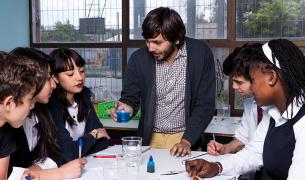Math in motion: Students tackling community challenges

Mathematical activism: The start of a journey
My venture into transforming math education was a fusion of personal drive and professional ambition. My early fascination with teaching, especially in math, was more than just academic interest—it was a calling. This passion was fueled by a pivotal math class, which reshaped my perception of mathematics as not just a subject, but a powerful instrument for understanding and influencing the world.
When I embarked on my journey into the realm of education, I chose to specialize in math education during my college years. Before even completing my degree, I was drawn to the mission of Teach For America and decided to join, eager to make a tangible difference. I was assigned to a school in Colorado Springs and was immediately confronted with the challenge of engaging students who seemed disconnected from the subject of math. This experience reinforced my commitment to transforming the way math is taught, aiming to make it more relevant and engaging for my students. During my tenure at a different school in Denver, I dedicated myself to refining my teaching skills. It was here that I developed an innovative curriculum that integrated mathematical concepts with community issues, thereby enhancing the relevance and impact of my lessons.
This approach revolutionized the traditional classroom, transforming math into a practical, engaging subject that extended beyond academic boundaries and into real-life applications. My vision was clear: to foster students’ empowerment through math, turning it into a tool for action and change
Math against the odds: Challenging the status quo
In my quest to reshape math education, I faced formidable challenges. I encountered a deep-rooted apathy towards mathematics among my students, who often saw it as irrelevant and uninteresting. This was compounded by a curriculum that traditionally emphasized rote memorization over practical application, making math seem disconnected from everyday life. Moreover, I grappled with limited resources and support in my school, a common issue in underfunded educational settings, and I also had to overcome the preconceived notions and resistance to change among my colleagues and the wider educational community, who were accustomed to conventional teaching methods. Another significant challenge was bridging the diverse learning styles and backgrounds of my students. Ensuring that each student could connect with and understand mathematical concepts required innovative and adaptable teaching strategies.
Finally, I aimed to not only teach math but to use it as a tool for social empowerment. This meant designing a curriculum that was not only educationally sound but also socially relevant and capable of inspiring students to apply mathematical concepts to real-world issues.
Pioneering a new path in math education
I developed a geometry project, using Atlanta's food deserts as a case study, which engaged my students in a meaningful societal challenge. After learning about food scarcity and conducting research, the students applied their newfound knowledge in geometry to propose solutions. They wrote a letter to the mayor of Atlanta, suggesting a specific location for a new grocery store based on their mathematical findings. This letter not only demonstrated their practical use of mathematics to address community issues, but also represented their active participation in civic engagement. Their proposal considered various factors like population density, infrastructure, and accessibility, showcasing their development from passive learners to active problem-solvers and community advocates. This project enhanced their understanding of geometry and also underscored the role of mathematics in societal change, with one student even pursuing a career in city planning as a result of this experience.
This innovative project led to a transformative shift in my classroom dynamics. My students' enthusiasm for applying math in real-world contexts grew, as did their academic performance. They began to show a deeper understanding of mathematical concepts, evidenced by improved scores on assessments.
More significantly, the project kindled a newfound engagement in students who previously showed little interest in math. Now eager to grasp basic concepts, these students aimed to tackle more complex problems. This shift was not just academic but cultural, creating a classroom environment where math was a tool for exploring and understanding the world.
The success of this project paved the way for incorporating more real-world applications into the curriculum, covering diverse topics like population modeling, climate change, and equity. My teaching approach evolved to include more student input in lesson planning, fostering a learning space that was responsive to students' interests and connected to global issues.
This approach demonstrated the power of math as a critical tool for understanding and addressing global challenges, empowering students to envision and work towards a better future. My role transcended that of a teacher; I became a facilitator of change, equipping my students with the tools and critical thinking skills necessary to make a meaningful impact in the world.
Looking forward
My goal is to extend this innovative approach to math education to classrooms worldwide. I acknowledge the challenges, and am aware of how math is often viewed as difficult and boring, as well as the way the pressure of standardized testing limits curriculum flexibility. However, I believe it is critical to re-engage students by focusing on practical applications, enhancing STEAM teaching, and involving students in shaping the future of education. I am committed to being a catalyst for this change, and am eager to collaborate with math educators globally to reimagine math classrooms, ensuring they address real-world problems and student interests.
For more from Taylor, watch this episode of our monthly EmployED Chat series where she is joined by Teach For Nepal student Anjali Lama for a discussion about inspiring the next generation of female STEM educators.



